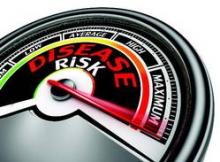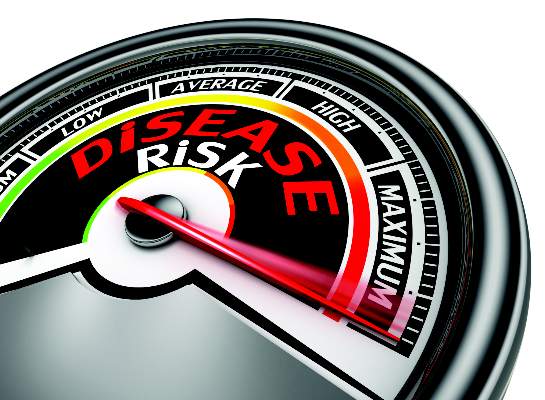User login
The addition of hemoglobin A1c to a type 2 diabetes risk prediction model greatly improved its performance among race-based populations, according to a new cohort study of white and African American populations.
However, while adding HbA1c to the existing Atherosclerosis Risk in Communities (ARIC) diabetes risk prediction model can improve its overall predictive value, the model is significantly more effective at predicting incidence of type 2 diabetes within white populations than among populations of African Americans (Diabetes Care. 2015 Dec 1. doi: 10.2337/dc15-0509).
“Results from the current analysis confirm our hypothesis that when type 2 diabetes prediction models are updated to include A1c, a reflection of current clinical practice for the diagnosis of type 2 diabetes, there exists a racial divide in model performance,” wrote Dr. Mary E. Lacy of Brown University, Providence, R.I.
The study enrolled 2,456 participants of the Coronary Artery Risk Development Study in Young Adults (CARDIA), an ongoing, multicenter, longitudinal study that began in 1985-1986 with 5,115 men and women aged 18-30 years: 2,637 African Americans and 2,478 whites. Dr. Lacy and her colleagues recruited from the year 20 group in 2005-2006. All subjects were diabetes free at baseline; the study excluded those who had prevalent diabetes or no diabetes data at year 20.
Follow-up was done after 5 years (year 25 from the start of CARDIA). The subjects had fasting and 2-hour postload glucose measured via the hexokinase ultraviolet method, as well as HbA1c, which was tested via a Tosoh G7 high-performance liquid chromatography instrument. These same measurements were taken at baseline in year 20. Model discrimination, calibration, and integrated discrimination improvement with incident diabetes were measured with these data, both before and after taking HbA1c into account, as defined by the American Diabetes Association’s 2010 guidelines.
Discrimination with the model for the overall population gave an area under the curve of 0.841, which investigators described as “good.” That number rose to 0.863 when factoring in HbA1c (P = .03). Similar increases in model discrimination were found in both white (0.875 to 0.902, P = .08) and African American (0.796 to 0.816, P = .14) populations.
“When racial subgroups in CARDIA were analyzed separately, model performance was better among whites than African Americans,” the authors concluded. “For all models that used ADA 2010 diagnostic guidelines, model discrimination was significantly higher in whites than African Americans [and] the addition of baseline A1c improved model discrimination in whites and African Americans to a similar degree.”
Integrated Discrimination Improvement analyses also showed that HbA1c substantially improved model discrimination for both the African-American and white cohorts. Furthermore, in the overall study population, “the 5-year incidence of type 2 diabetes was 3.0% (n = 74) under the ADA 2004 diagnostic guidelines versus 5.1% (n = 124) using the ADA 2010 guidelines.” African Americans were found to be slightly more at risk for developing type 2 diabetes compared with whites.
Dr. Lacy and her colleagues concluded by saying these findings highlight the need for discrimination models to use the 2010 American Diabetes Association guidelines and incorporate HbA1c as a parameter. However, further study is needed to find a predictive model as effective for African Americans and other racial minorities as the model in this trial turned out to be for whites.
The researchers did not report any conflicts of interest. The National Heart, Lung, and Blood Institute and the National Institute on Aging funded the study.
The addition of hemoglobin A1c to a type 2 diabetes risk prediction model greatly improved its performance among race-based populations, according to a new cohort study of white and African American populations.
However, while adding HbA1c to the existing Atherosclerosis Risk in Communities (ARIC) diabetes risk prediction model can improve its overall predictive value, the model is significantly more effective at predicting incidence of type 2 diabetes within white populations than among populations of African Americans (Diabetes Care. 2015 Dec 1. doi: 10.2337/dc15-0509).
“Results from the current analysis confirm our hypothesis that when type 2 diabetes prediction models are updated to include A1c, a reflection of current clinical practice for the diagnosis of type 2 diabetes, there exists a racial divide in model performance,” wrote Dr. Mary E. Lacy of Brown University, Providence, R.I.
The study enrolled 2,456 participants of the Coronary Artery Risk Development Study in Young Adults (CARDIA), an ongoing, multicenter, longitudinal study that began in 1985-1986 with 5,115 men and women aged 18-30 years: 2,637 African Americans and 2,478 whites. Dr. Lacy and her colleagues recruited from the year 20 group in 2005-2006. All subjects were diabetes free at baseline; the study excluded those who had prevalent diabetes or no diabetes data at year 20.
Follow-up was done after 5 years (year 25 from the start of CARDIA). The subjects had fasting and 2-hour postload glucose measured via the hexokinase ultraviolet method, as well as HbA1c, which was tested via a Tosoh G7 high-performance liquid chromatography instrument. These same measurements were taken at baseline in year 20. Model discrimination, calibration, and integrated discrimination improvement with incident diabetes were measured with these data, both before and after taking HbA1c into account, as defined by the American Diabetes Association’s 2010 guidelines.
Discrimination with the model for the overall population gave an area under the curve of 0.841, which investigators described as “good.” That number rose to 0.863 when factoring in HbA1c (P = .03). Similar increases in model discrimination were found in both white (0.875 to 0.902, P = .08) and African American (0.796 to 0.816, P = .14) populations.
“When racial subgroups in CARDIA were analyzed separately, model performance was better among whites than African Americans,” the authors concluded. “For all models that used ADA 2010 diagnostic guidelines, model discrimination was significantly higher in whites than African Americans [and] the addition of baseline A1c improved model discrimination in whites and African Americans to a similar degree.”
Integrated Discrimination Improvement analyses also showed that HbA1c substantially improved model discrimination for both the African-American and white cohorts. Furthermore, in the overall study population, “the 5-year incidence of type 2 diabetes was 3.0% (n = 74) under the ADA 2004 diagnostic guidelines versus 5.1% (n = 124) using the ADA 2010 guidelines.” African Americans were found to be slightly more at risk for developing type 2 diabetes compared with whites.
Dr. Lacy and her colleagues concluded by saying these findings highlight the need for discrimination models to use the 2010 American Diabetes Association guidelines and incorporate HbA1c as a parameter. However, further study is needed to find a predictive model as effective for African Americans and other racial minorities as the model in this trial turned out to be for whites.
The researchers did not report any conflicts of interest. The National Heart, Lung, and Blood Institute and the National Institute on Aging funded the study.
The addition of hemoglobin A1c to a type 2 diabetes risk prediction model greatly improved its performance among race-based populations, according to a new cohort study of white and African American populations.
However, while adding HbA1c to the existing Atherosclerosis Risk in Communities (ARIC) diabetes risk prediction model can improve its overall predictive value, the model is significantly more effective at predicting incidence of type 2 diabetes within white populations than among populations of African Americans (Diabetes Care. 2015 Dec 1. doi: 10.2337/dc15-0509).
“Results from the current analysis confirm our hypothesis that when type 2 diabetes prediction models are updated to include A1c, a reflection of current clinical practice for the diagnosis of type 2 diabetes, there exists a racial divide in model performance,” wrote Dr. Mary E. Lacy of Brown University, Providence, R.I.
The study enrolled 2,456 participants of the Coronary Artery Risk Development Study in Young Adults (CARDIA), an ongoing, multicenter, longitudinal study that began in 1985-1986 with 5,115 men and women aged 18-30 years: 2,637 African Americans and 2,478 whites. Dr. Lacy and her colleagues recruited from the year 20 group in 2005-2006. All subjects were diabetes free at baseline; the study excluded those who had prevalent diabetes or no diabetes data at year 20.
Follow-up was done after 5 years (year 25 from the start of CARDIA). The subjects had fasting and 2-hour postload glucose measured via the hexokinase ultraviolet method, as well as HbA1c, which was tested via a Tosoh G7 high-performance liquid chromatography instrument. These same measurements were taken at baseline in year 20. Model discrimination, calibration, and integrated discrimination improvement with incident diabetes were measured with these data, both before and after taking HbA1c into account, as defined by the American Diabetes Association’s 2010 guidelines.
Discrimination with the model for the overall population gave an area under the curve of 0.841, which investigators described as “good.” That number rose to 0.863 when factoring in HbA1c (P = .03). Similar increases in model discrimination were found in both white (0.875 to 0.902, P = .08) and African American (0.796 to 0.816, P = .14) populations.
“When racial subgroups in CARDIA were analyzed separately, model performance was better among whites than African Americans,” the authors concluded. “For all models that used ADA 2010 diagnostic guidelines, model discrimination was significantly higher in whites than African Americans [and] the addition of baseline A1c improved model discrimination in whites and African Americans to a similar degree.”
Integrated Discrimination Improvement analyses also showed that HbA1c substantially improved model discrimination for both the African-American and white cohorts. Furthermore, in the overall study population, “the 5-year incidence of type 2 diabetes was 3.0% (n = 74) under the ADA 2004 diagnostic guidelines versus 5.1% (n = 124) using the ADA 2010 guidelines.” African Americans were found to be slightly more at risk for developing type 2 diabetes compared with whites.
Dr. Lacy and her colleagues concluded by saying these findings highlight the need for discrimination models to use the 2010 American Diabetes Association guidelines and incorporate HbA1c as a parameter. However, further study is needed to find a predictive model as effective for African Americans and other racial minorities as the model in this trial turned out to be for whites.
The researchers did not report any conflicts of interest. The National Heart, Lung, and Blood Institute and the National Institute on Aging funded the study.
FROM DIABETES CARE
Key clinical point: Adding hemoglobin A1c to the existing Atherosclerosis Risk in Communities diabetes risk prediction model can significantly improve the accuracy of diabetes incidence prediction in white and African-American populations.
Major finding: With new parameters for prediction, model discrimination increased from 0.841 to 0.863 in the overall population, 0.796 to 0.816 among African Americans, and 0.875 to 0.902 among whites.
Data source: Cohort study of 2,456 white and African American participants in the CARDIA study in 2005-2006 who did not have diabetes.
Disclosures: The National Heart, Lung, and Blood Institute and the National Institute on Aging funded the study. The authors reported no conflicts of interest.

